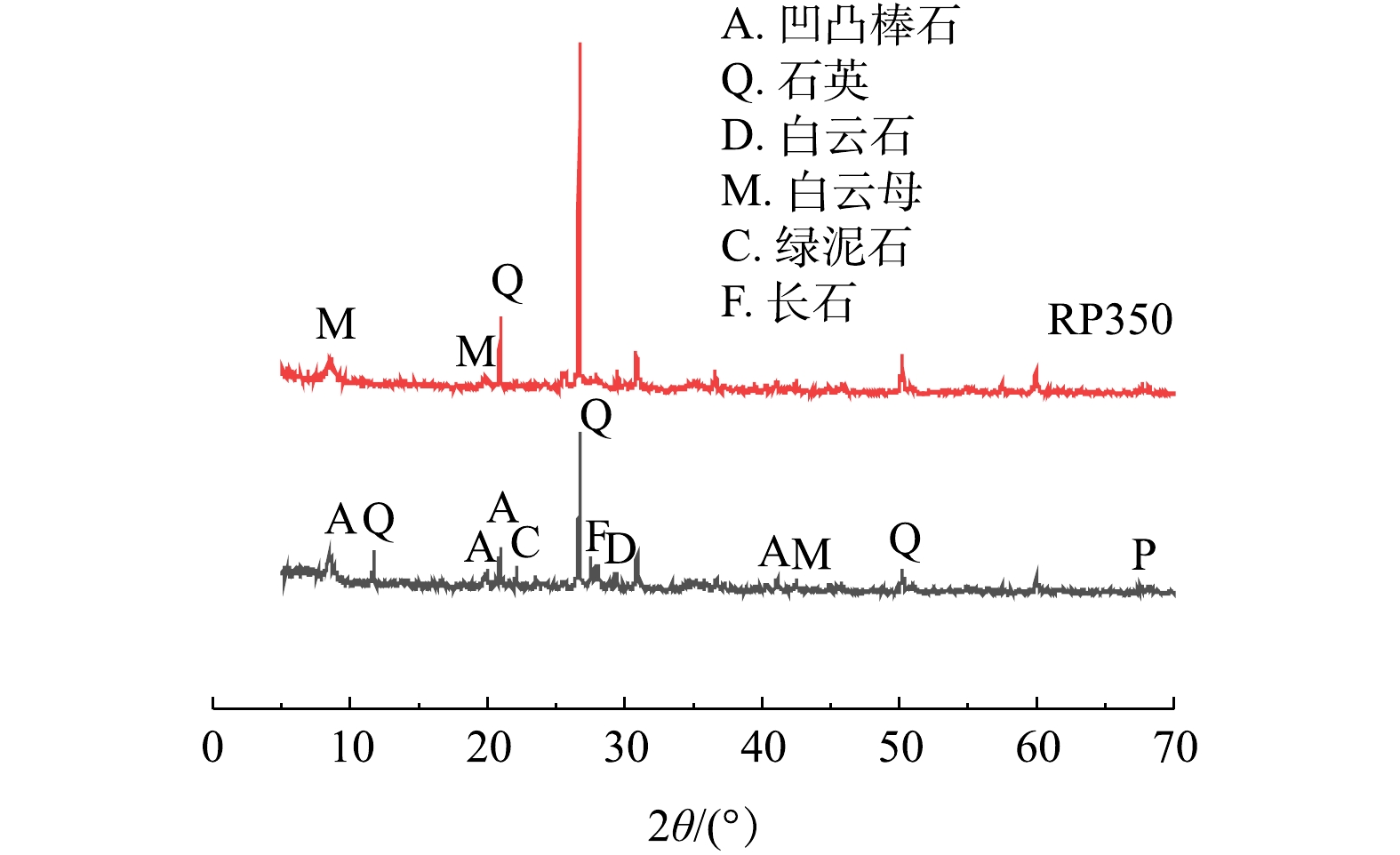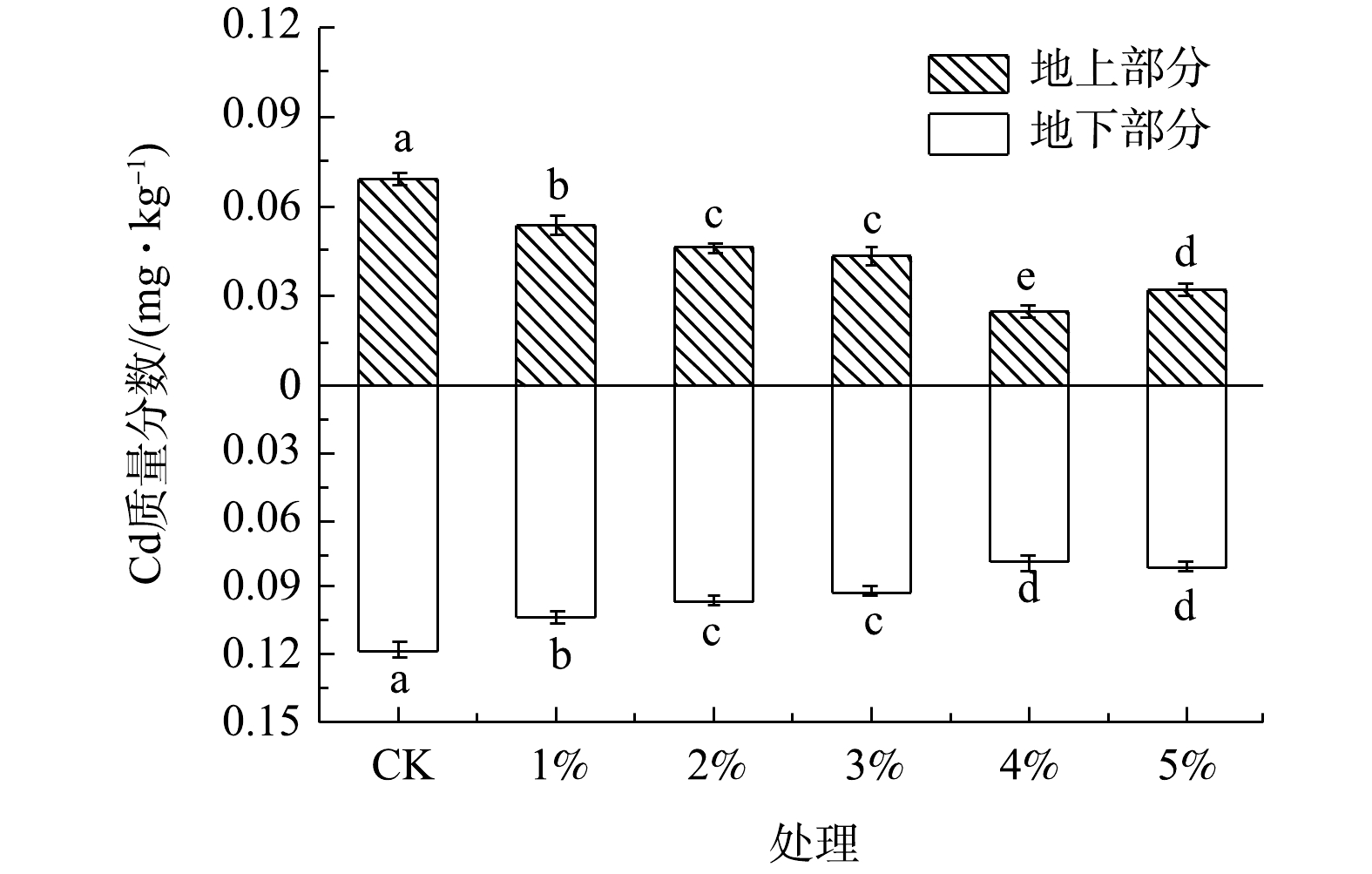-
镉(Cd)、铅(Pb)、锌(Zn)、铜(Cu)等重金属元素进入土壤环境后,可对食品安全造成危害[1-2]。其中,Cd具有极强的迁移能力,在土壤中易被农作物吸收和富集,对人类食品安全产生较大危害[3-4]。
钝化修复技术是指向污染土壤中添加钝化材料,通过吸附、沉淀等反应,阻碍土壤中重金属的迁移,从而降低重金属生物利用度的土壤修复方法[5-7]。目前,用于土壤修复的钝化材料多采用黏土矿物,如坡缕石、膨润土、海泡石、沸石等。其中,坡缕石是一种富含镁铝型黏土矿物,该矿物在我国产量丰富、价格低廉且具较强的离子交换能力和良好的吸附性能[8-9]。但是,因坡缕石自身孔道紧密且含大量杂质成分,使其使用效率较低。为此,通常需对坡缕石原矿进行改性处理。坡缕石改性方法主要分为物理方法和化学方法。常见的物理改性方法主要有高温、超声波、微波改性等;而化学改性主要以酸碱改性与有机改性为主[10]。近年来,热改性处理倍受研究者关注,但大多仅局限于热改性坡缕石的制备及水体污染修复研究[11-12]。廖启林等[13]研究表明,坡缕石因比表面积大、吸附性能强,可将土壤中可溶性重金属元素吸附在其表明或固定于矿层间结构中。而章绍康等[11]发现,温度升高可脱出坡缕石晶体内各类型水,使坡缕石孔隙度、比表面积增大,从而提高其对重金属的吸附容量。
本研究采用高温煅烧法制得热改性坡缕石,并对其物化性质进行表征;同时,考察其对土壤中Cd的钝化效果,以期为Cd污染土壤修复及坡缕石品质提升提供参考。
全文HTML
-
供试土壤为农田表层土壤(1~2 cm),采自齐齐哈尔市依安县新兴镇西发村。土样采回后,压碎、除去残根杂物;经自然风干后过100目筛,装密封袋内保存。所测定的土壤基本理化性质为:土壤pH为7.44、土壤阳离子交换量为17.00 cmol·kg−1、土壤电导率为162.30 μS·cm−1、总Cd质量分数为0.18 mg·kg−1。
坡缕石原矿采自甘肃省临泽县板桥镇。其主要矿物组成为凹凸棒石、石英、长石、白云石、绿泥石、白云母等。测得其pH为8.24、阳离子交换量为17.81 cmol·kg−1、Cd质量分数为0.19 mg·kg−1。通过前期对热改性坡缕石的筛选实验结果,本研究选用的热改性坡缕石是由坡缕石原矿经机械破碎和分筛(100目)后以350 ℃的温度在真空热解炉中热解2.5 h并过200目筛制备而成。
盆栽实验所使用玉米种子为陇单4号,购自甘肃省农业科学院。
-
首先,参照国家《土壤环境质量农用地土壤污染风险管控标准》(GB 15618-2018)[14]配制0.50 g·L−1的Cd(NO3)2溶液,将其均匀加入到完成预处理的农田土壤样品中,得到2.00 mg·kg−1的模拟Cd污染土壤;然后,使模拟Cd污染土壤维持70%的土壤含水率,于室温稳定21 d后,风干、过筛(100目);之后,利用HF-HClO4-HNO3法进行消解,所得消解液经真空抽滤(0.45 μm)后,利用火焰原子分光光度吸收仪测定模拟污染土壤中Cd质量分数为1.89 mg·kg−1;最后,将热改性坡缕石按1%、2%、3%、4%、5%的投加量分别加入到1.50 kg模拟Cd污染土壤中,继续保持70%土壤含水率,并于室温条件下钝化30 d。同时,以不添加热改性坡缕石土壤为空白对照,每种处理重复3次。钝化30 d后,测定模拟污染土壤的理化性质、生物有效态Cd质量分数及化学形态组成。
在完成钝化实验的模拟土壤表层(1~2 cm),于室温(25 ℃)均匀播种15粒玉米种子,播种后喷洒少量去离子水保持土壤湿润。待出苗后培养7 d,间苗至3株,让其继续生长30 d后,分地下(根部)和地上(茎部) 2部分收获玉米幼苗,同时测量根茎鲜重、根长和株高。然后,用去离子水将各部分幼苗冲洗、烘干(65 ℃)、剪碎研磨过筛,测定植株内不同部位Cd质量分数。
-
使用pH计与电导率仪,以不同土水比(1∶2.5、1∶5)测定土壤pH及电导率(EC);阳离子交换量(CEC)采用乙酸铵交换法测定;土壤有效态Cd质量分数采用DTPA提取法及TCLP毒性浸出法提取测定;采用BCR连续提取法对土壤Cd形态分级进行测定[14];植物各部位Cd质量分数利用HNO3-HClO4法消解;土壤及植物中Cd质量分数均利用火焰原子分光光度吸收仪测定;采用X射线衍射仪对热改性坡缕石晶体结构进行表征;采用JSM-6701F型扫描电子显微镜(SEM)对热改性坡缕石的微观形态进行分析。
-
1)生物富集系数(biological concentration factor, BCF)和转运系数(translocation factor, TF)计算如式(1)和式(2)所示。
式中:C土壤为土壤中Cd质量分数;C地上为植物地上部分Cd质量分数;C地下为植物地下部分Cd质量分数。
2)重金属修复效率(remediation ratio of heavy metal, RRm)计算如式(3)所示[15]。
式中:F1为酸溶态组分;F2为可还原态组分;F3为可氧化态组分;F4为残渣态组分。
3)生物吸收因子(biological uptaking factor, BUF)如式(4)所示[16]。
式中:C地上为植物地上部分Cd质量分数;B地上为植物地上部分生物量;C地下为植物地下部分Cd质量分数;B地下为植物地下部分生物量。
采用Statistic 7.0 软件对试验数据进行统计分析;利用Origin 2019b软件作图,采用Duncan多重比较检验法分析不同处理各指标差异的显著性。
1.1. 实验材料
1.2. 实验方法
1.3. 样品测定方法
1.4. 数据处理
-
图1为坡缕石热改性前后的SEM对比图。由图1可知,坡缕石主要以晶束聚集体形式存在,且其表面棒状结构明显(图1(a))。而坡缕石经热改性处理后,可脱除其表面各类水,使聚集体之间结构疏松,孔道变宽(图1(b))。有研究结果表明,改性坡缕石对土壤中重金属的去除主要与其吸附性能及比表面积有关,而当煅烧温度为350 ℃时,可达到对土壤重金属的最大吸附量[16-17]。但在潘敏等[18]的研究中,热改性活化坡缕石最佳的煅烧温度为700 ℃。其原因是,坡缕石产地不同,性能及化学组成可能有所差别。
图2为坡缕石热改性前后的XRD图谱。如图所示,坡缕石主要由凹凸棒石、石英、白云石、白云母、绿泥石、长石等矿物质组成(图2)。经过350 ℃ 煅烧后,坡缕石特征峰位置并未发生明显变化,只是部分特征峰强度发生了改变。这说明,350 ℃的煅烧处理并未改变坡缕石结构及物质组成,只是除去了其表面的吸附水与部分结晶水,从而使得其结构孔道变宽、比表面积增加,以更利于其发挥吸附作用[15]。
-
土壤pH、电导率与阳离子交换量是评价土壤供肥蓄肥能力及吸附重金属能力的重要指标[19-20]。经热改性坡缕石处理后,模拟土壤的理化性质见表1。与对照土壤相比,添加热改性坡缕石处理组土壤pH、电导率和阳离子交换量均呈升高趋势。电导率和阳离子交换量在不同处理间均存在显著性差异,但pH在添加量较高(4% 和5%)的处理组间无显著差异。其中,添加4%热改性坡缕石处理组,较对照组土壤 pH增加了0.79个单位,电导率增加了496.00 μS·cm−1,阳离子交换量增加了4.00 cmol·kg−1,变化最显著(表1)。以上结果产生的可能原因为:1)坡缕石材料呈碱性含有羟基等基团,添加到土壤后能够调节土壤的酸碱环境,进而使土壤pH升高[21-22];2)坡缕石自身具有极高的阳离子交换量(17.81 cmol·kg−1),添加坡缕石可进一步提高土壤阳离子交换量;3)坡缕石具极强的吸附性能,可与土壤颗粒发生反应从而使土壤阳离子交换量升高[13, 23]。
土壤中有效态重金属,主要是以离子状态吸附于带电荷的土壤胶体表面,可被植物所吸收利用的重金属组分,通常作为评价土壤污染程度的重要指标[24]。在本研究中,选用DTPA提取法与TCLP毒性浸出实验对污染土壤进行土壤污染程度评价(图3)。研究结果表明,添加热改性坡缕石,两种提取态Cd质量分数均有显著降低趋势,其中热改性坡缕石添加量为4%时,两种提取态Cd质量分数降低最显著,DTPA-Cd质量分数和TCLP-Cd质量分数降幅分别为26.42%~56.72%和20.16%~55.81%(图3)。其原因是:一方面,可能是因为高温煅烧造成晶格内部孔道断键,使其聚集的棒状结构变得疏松多孔,孔隙容积和比表面积增加,使土壤中可溶性重金属吸附于其表面或进入层间结构进行固定[11, 25];另一方面,可能与坡缕石的使用可提高土壤pH和阳离子交换量,从而有效抑制农作物对土壤中重金属的吸收有关[23]。但添加5%热改性坡缕石处理组中,两种提取态 Cd质量分数分别较添加4%热改性坡缕石处理组增加17.24%和24.56%(图3),这说明控制好热改性坡缕石添加量,对于土壤中重金属钝化修复同样至关重要。
-
土壤中重金属对环境的危害程度一方面与重金属总量有关;另一方面也由其化学形态决定。通过添加钝化剂改变重金属化学形态,可减轻其可迁移性和生物有效性,从而减少对人群和环境造成的危害[26-27]。其中,酸溶态重金属具有极强的可迁移性和生物有效性,最易被植物吸收富集,是植物体内重金属的主要来源[28]。热改性坡缕石钝化土壤中Cd的化学形态质量分数及修复效率如表2所示。添加热改性坡缕石后,可显著降低土壤中酸溶态Cd质量分数,较对照组可降低4.30%~37.14%。其中,添加4%热改性坡缕石处理组下降最显著。相反,可氧化态与残渣态Cd质量分数呈递增趋势。其中,残渣态质量分数变化较显著,较对照组可增加16.01%~22.70%(表2)。同时,添加热改性坡缕石可显著提升土壤的修复效率,较对照组可分别增加6.16%~12.09%。其中,添加4%热改性坡缕石处理组的修复效率最高,可达42.79%(表2)。
图4为热改性坡缕石钝化土壤中Cd的形态分布。对照土壤中酸溶态、可还原态、可氧化态和残渣态的质量分数分别占土壤总Cd量的32.89%、25.88%、10.38%和32.85%。这说明,在对照土壤中,Cd主要以酸溶态形式存在,危害性极强(图4)。添加热改性坡缕石钝化的土壤中,酸溶态Cd质量分数逐渐降低,残渣态质量分数逐渐升高,可还原态和可氧化态Cd质量分数变化不明显。这表明,热改性坡缕石可使土壤中部分酸溶态Cd转化为残渣态,从而实现对Cd的固定。其主要原因可能是:1)坡缕石是一种链层状镁铝硅酸盐矿物,溶解后产生的各种硅酸根离子等可与酸溶态Cd结合形成一些难溶性物质,比如硅酸镉和偏硅酸镉[28];2)添加坡缕石可提高土壤pH,增加负电荷量,在一定程度上可促进重金属由溶解态转化为难溶态,从而降低其生物可利用性[29-30];3)坡缕石经热改性后,可脱除其表面的吸附水与部分结晶水,使坡缕石结构孔道变宽,比表面积增加,对重金属的吸附性增强,进而降低土壤中活性较高的酸溶态Cd质量分数。
-
钝化材料通过吸附或沉淀作用可降低土壤溶液中重金属离子浓度及活性,使农作物免受重金属的毒害[31],进而提高农产品质量。热改性坡缕石处理的土壤中玉米植株的生长状况如图5所示。在不同热改性坡缕石处理土壤中,玉米植株茎鲜重较对照组可分别增加57.74%、41.51%、57.82%、86.12%和49.93%;根鲜重可分别增加9.69%、9.96%、10.60%、11.41%和10.87%(图5(a));根长、株高增幅分别为19.06%~37.84% 与5.95%~35.60%(图5(b))。这表明,添加热改性坡缕石可以减缓重金属Cd污染对玉米植株生长的抑制作用,这与许剑臣等[32]和任静华等[23]的研究结果一致。其主要原因可能是,一方面坡缕石材料自身富含钙镁等多种微量元素可有效调节作物生长[33];另一方面坡缕石可有效地吸附土壤中对作物有利的营养元素,保持并调节土壤肥力从而促进作物生长[34]。此外,土壤pH等理化性质的提高、有效态Cd质量分数的降低可能也为作物生长提供一个相对良好的生长环境。
使用钝化材料可降低重金属污染土壤中镉离子活性、减少植物体内Cd积累[13]。图6为添加热改性坡缕石处理土壤中,玉米幼苗各部分的Cd质量分数。其中,地上、地下部分Cd质量分数,较对照组降幅分别为21.74%~63.77%和12.71%~33.05%(图6),而添加4%热改性坡缕石处理组降低最显著。并且,在相同添加条件下,地上部分Cd质量分数明显低于地下部分。
通常,可用生物富集系数(BCF)反映植物体内各部位重金属富集能力,用转运系数(TF)表征植物某一组织向另一组织转运重金属的能力,用生物吸收因子(BUF)反映植物对重金属的吸收情况[16, 35-36]。在本研究中,添加热改性坡缕石,重金属富集系数、转运系数及生物吸收因子整体降低。其中,4%热改性坡缕石处理组降至最低,分别较对照组可降低63.84%、45.87%和44.00%。这说明,添加热改性坡缕石可减缓玉米幼苗对重金属吸收富集;相比地上部分,地下部分有较强重金属富集能力(表3)。有研究结果表明,这可能是因为植物根系发达,吸附能力强,使得土壤中重金属被吸附、沉淀后积累在植物根部,进而阻碍了重金属在植物体内的迁移[37-38]。
-
钝化土壤理化性质、有效态Cd质量分数、Cd化学形态与玉米生长、Cd质量分数的相关性如表4所示。玉米幼苗各部分Cd质量分数与土壤pH、电导率、阳离子交换量及氧化态和残渣态Cd质量分数间存在显著负相关关系,但与土壤有效态Cd质量分数、酸溶态和可还原态Cd质量分数显著正相关(P < 0.01)(表4)。这可能是因为,土壤pH、阳离子交换量等理化性质的提高,可改变土壤中重金属的化学赋存形态。随着酸溶态与可还原态Cd质量分数降低,可氧化态和残渣态Cd质量分数升高,土壤中可被植物利用的有效态Cd质量分数降低,进而抑制了玉米幼苗对Cd的吸收富集。这与任静华等[23]和冉洪珍等[39]的研究结果一致。同时,玉米幼苗鲜重、根长和株高与土壤残渣态Cd质量分数间呈显著正相关,与有效态Cd质量分数呈负相关(P < 0.05),这证实了增加土壤中残渣态Cd质量分数,可减缓玉米幼苗中Cd的富集,进一步提高玉米幼苗生物量,改善其生长状况。这与MUSTAFA等[37]的研究结果相似。
2.1. 热改性坡缕石表征
2.2. 热改性坡缕石对土壤理化性质和Cd有效态的影响
2.3. 热改性坡缕石对土壤Cd化学形态的影响
2.4. 热改性坡缕石对玉米幼苗生长及Cd富集转运的影响
2.5. 相关性分析
-
1)添加4%热改性坡缕石对污染土壤的钝化效果最佳,可显著改善土壤理化性质,使土壤DTPA与TCLP提取态Cd质量分数分别降低56.94%和55.81%。
2)添加热改性坡缕石,可促使Cd由高活性酸溶态向低活性残渣态转换,其中4%热改性坡缕石处理组可使修复效率增加12.09%。
3) 4%热改性坡缕石处理组,较空白对照组中根长和株高可分别提高37.84%和35.60%,根、茎鲜重分别增加11.41%和86.12%,生物吸收因子降低44.00%,可显著改善玉米幼苗生长状况,降低Cd的生态毒性。




 下载:
下载:






